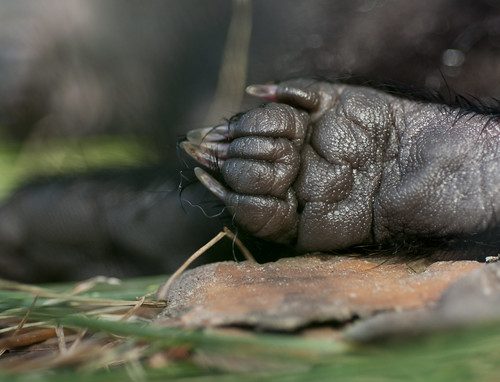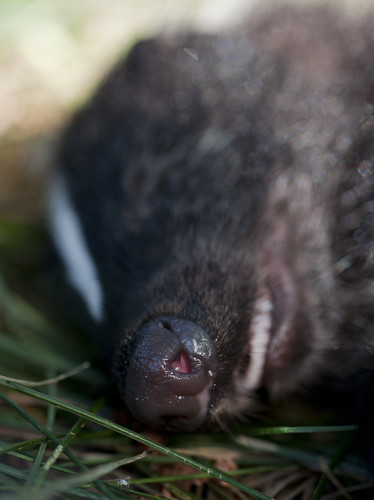I've seen many different animals dead along this stretch of highway: deer, raccoons, foxes, skunks, squirrels, porcupines, and even an opossum. With the volume of traffic along M-28 so low (as compared to that of downstate, for example), I sometimes wonder how cars manage to hit skunks and porcupines, as they are such slow and bumbling animals. One has to remember, however, that many of these animals are out at night, and this highway becomes very, very dark once the sun sets.
On a recent trip down M-28 toward Munising, we found a freshly-dead skunk. Her nose was still wet, her teeth were so white and sharp, and she was tiny: a kit from this year, she was about the size of a healthy Ann Arbor fox squirrel.
We brought the body home, double-bagging it for two reasons. For one, her scent glands hadn't been ruptured, but she still did smell like a skunk, and even more importantly, her face was covered in deer ticks. I'd never seen deer ticks before -- and I could have lived without ever seeing them -- but when we got home, we picked off nearly forty of them from the poor skunk's face alone. They're tinier than dog ticks, and are vectors for all sorts of nasty diseases, so extra care had to be taken.
I cleaned up the skunk, washing her with a mixture of water, peroxide, dishsoap, and baking soda, to both help eliminate the skunky scent, as well as to kill the lice, fleas, and remaining ticks. I promptly froze the body in our new chest freezer, and took pictures the next day after everything had thawed.

I've found that skunk feet are amazing. Their front claws are long and sharp -- for digging out tasty grubs -- and their back paws are fleshy and, oddly enough, very much like baby feet.
After I finished photographing the little skunk, I case skinned the body. It was my first time trying this method of skinning, and I found it to be far easier than ventral skinning, which I've done on a squirrel and a chipmunk. Special care had to be taken around the skunk's scent glands. They were located at the base of the tail, and I was shocked by how large they were, for a skunk of such small size.
The face was the last part of the body to be skinned, and when the fur was pulled away, sharp teeth and powerful jaw muscles were revealed. I buried the corpse in our backyard, near the raccoon; it's certainly a better place to decompose, rather than languishing in the center of the road.
Why skin an animal? For me, the reasons are twofold. Obviously, it's a learning experience. When the skin is stripped away, left behind is the body, sleek and muscular and bony, no longer obscured by fur. It's fascinating to see, and I'm constantly surprised at how delicate these animals are, their ribcages so frail beneath my fingers. Secondly, it's my goal to learn how to skin, tan, and eventually mount animals. Taxidermy has long been an interest of mine, and seeing all the creatures in the Mammal Division really made me revisit this interest.
This little skunk won't become a taxidermy mount; what she will become is a tanned pelt, as well as beetle food and, ultimately, food for the soil.
After I finished photographing the little skunk, I case skinned the body. It was my first time trying this method of skinning, and I found it to be far easier than ventral skinning, which I've done on a squirrel and a chipmunk. Special care had to be taken around the skunk's scent glands. They were located at the base of the tail, and I was shocked by how large they were, for a skunk of such small size.
The face was the last part of the body to be skinned, and when the fur was pulled away, sharp teeth and powerful jaw muscles were revealed. I buried the corpse in our backyard, near the raccoon; it's certainly a better place to decompose, rather than languishing in the center of the road.
Why skin an animal? For me, the reasons are twofold. Obviously, it's a learning experience. When the skin is stripped away, left behind is the body, sleek and muscular and bony, no longer obscured by fur. It's fascinating to see, and I'm constantly surprised at how delicate these animals are, their ribcages so frail beneath my fingers. Secondly, it's my goal to learn how to skin, tan, and eventually mount animals. Taxidermy has long been an interest of mine, and seeing all the creatures in the Mammal Division really made me revisit this interest.
This little skunk won't become a taxidermy mount; what she will become is a tanned pelt, as well as beetle food and, ultimately, food for the soil.





Very brave to skin a skunk. Truly, your photographs are amazing. There is beauty in even their paws and noses. Wonderful!
ReplyDeleteInteresting. Also I wanted to let you know that your page keeps redirecting me to spam websites. It made it difficult to read your blog. I will be back for more. Enjoyed it.
ReplyDelete